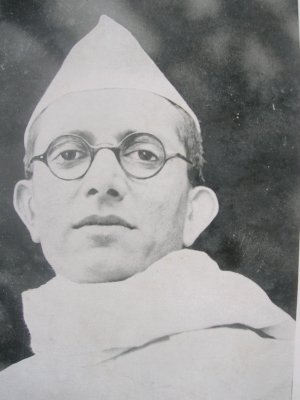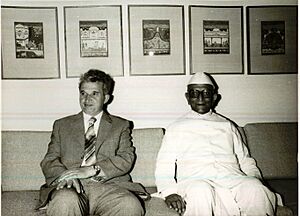Morarji Desai facts for kids
Quick facts for kids
Morarji Desai
|
|
|---|---|
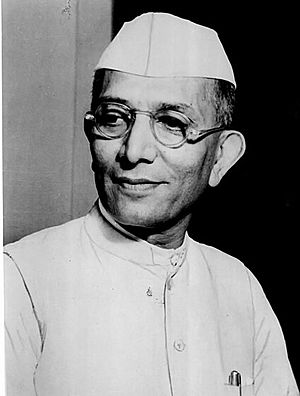
Desai in 1978
|
|
| 4th Prime Minister of India | |
| In office 24 March 1977 – 28 July 1979 |
|
| President | Neelam Sanjiva Reddy |
| Vice President | B. D. Jatti |
| Deputy |
|
| Preceded by | Indira Gandhi |
| Succeeded by | Charan Singh |
| Minister of Home Affairs | |
| In office 1 July 1978 – 24 January 1979 |
|
| Preceded by | Charan Singh |
| Succeeded by | Hirubhai M. Patel |
| 2nd Deputy Prime Minister of India | |
| In office 13 March 1967 – 16 July 1969 |
|
| Prime Minister | Indira Gandhi |
| Preceded by | Sardar Vallabhbhai Patel |
| Succeeded by | |
| Minister of Finance | |
| In office 13 March 1967 – 16 July 1969 |
|
| Prime Minister | Indira Gandhi |
| Preceded by | Sachindra Chaudhuri |
| Succeeded by | Indira Gandhi |
| In office 13 March 1958 – 29 August 1963 |
|
| Prime Minister | Jawaharlal Nehru |
| Preceded by | Jawaharlal Nehru |
| Succeeded by | T. T. Krishnamachari |
| 2nd Chief Minister of Bombay State | |
| In office 21 April 1952 – 31 October 1956 |
|
| Preceded by | B. G. Kher |
| Succeeded by | Yashwantrao Chavan |
| Member of Parliament, Lok Sabha | |
| In office 1957–1980 |
|
| Constituency | Surat |
| Personal details | |
| Born |
Morarji Ranchhodji Desai
29 February 1896 Bhadeli, Bombay Presidency, British India (present-day Valsad, Gujarat, India) |
| Died | 10 April 1995 (aged 99) Bombay, Maharashtra, India (present-day Mumbai) |
| Political party | Janata Dal (1988-1995) |
| Other political affiliations |
|
| Spouse |
Gujraben Desai (m. 1911)
|
| Alma mater | University of Mumbai |
| Profession |
|
| Awards | Bharat Ratna (1991) Nishan-e-Pakistan (1990) |
| Signature |  |
Morarji Ranchhodji Desai (born February 29, 1896 – died April 10, 1995) was an important Indian independence activist and politician. He became the 4th Prime Minister of India from 1977 to 1979. He led the government formed by the Janata Party.
During his long career, he held many key positions in the Indian government. These included Chief Minister of Bombay State, Home Minister, Finance Minister, and Deputy Prime Minister. He was the first Prime Minister of India who was not from the Indian National Congress party.
Desai was known for his efforts to bring peace between Pakistan and India. He also worked to improve relations with China. He promised that India would not use nuclear weapons. He was the oldest person to become Prime Minister of India, taking office at 81 years old. He received India's highest civilian award, the Bharat Ratna. He also received Pakistan's highest civilian award, the Nishan-e-Pakistan.
Contents
Early Life and Education
Birth and Family
Morarji Desai was born into a Gujarati family on February 29, 1896. He was born in Bhadeli village, which was then part of British India. Today, this area is in Valsad, Gujarat, India. His father, Ranchhodji Nagarji Desai, was a school teacher. Morarji was the oldest of eight children.
Schooling and First Job
Desai went to school in The Kundla School and later Bai Ava Bai High School in Valsad. After finishing his education, he worked as a deputy collector in Godhra. He resigned from this job in May 1930.
Joining the Freedom Fight
After leaving his job, Desai joined the movement to free India from British rule. He followed the teachings of Mahatma Gandhi and took part in the civil disobedience movement. He spent many years in jail because of his activism.
His strong leadership skills made him a respected figure among freedom fighters. He became an important leader of the Indian National Congress in the Gujarat region. When elections were held in 1934 and 1937, Desai was elected. He served as the Revenue Minister and Home Minister of the Bombay Presidency.
Key Roles in Government
Leading Bombay State
Before India became independent, Desai served as Bombay's Home Minister. In 1952, he was elected Chief Minister of Bombay state. During this time, many people wanted states to be divided based on the languages spoken. Bombay was a state where both Gujarati-speaking and Marathi-speaking people lived.
Desai was against dividing states by language. He suggested that Mumbai should be a separate area managed by the central government. He believed this would help the city, which had people from many different backgrounds. This led to protests and violence. Desai ordered the police to fire on protesters, and 105 people died. This event is believed to have made the government agree to create two separate states based on language. After this, Bombay became the capital of the new state of Maharashtra. The place where the firing happened was renamed "Hutatma Chowk" (Martyrs' Square).
Working with Prime Minister Nehru
Later, Desai moved to Delhi and became the Finance Minister in Prime Minister Jawaharlal Nehru's cabinet. Desai believed in free enterprise and business-friendly policies. This was different from Nehru's focus on socialist policies. Desai was known for being a strong nationalist and against corruption. As Nehru's health declined, Desai was seen as a possible future Prime Minister.
Contesting for Prime Minister
After Prime Minister Nehru passed away in 1964, Desai was a candidate for the top job. However, Lal Bahadur Shastri, who was Nehru's close associate, became Prime Minister instead. Desai did not join Shastri's cabinet.
In 1966, Prime Minister Shastri died unexpectedly. Desai again tried for the Prime Minister's position. But he was defeated by Nehru's daughter, Indira Gandhi, in the Congress party election.
Serving in Indira Gandhi's Cabinet
Desai served as Deputy Prime Minister and Finance Minister in Indira Gandhi's government. This lasted until July 1969. At that time, Prime Minister Gandhi took the finance job from him. Desai then resigned from her cabinet.
In Opposition and Emergency Rule
In 1969, the Congress party split into two groups. Desai joined the Indian National Congress (Organisation) faction. Indira Gandhi formed a new group. In the 1971 elections, Indira Gandhi's group won by a lot. Desai, however, was elected as a member of the Lok Sabha, which is the lower house of Parliament.
In 1975, Indira Gandhi faced issues with her election. During a period called the "Emergency" (1975–77), Desai and other opposition leaders were put in jail.
The Janata Party Victory
After the Emergency ended in 1977, many opposition parties joined together. They formed the Janata Party. This new party won the national elections in March 1977 by a large margin. Desai was chosen to lead the Janata Party in Parliament. This made him the first Prime Minister of India who was not from the Congress party.
Prime Minister of India (1977-1979)
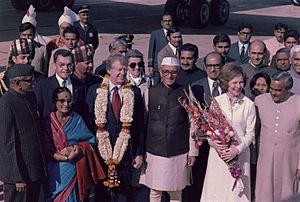
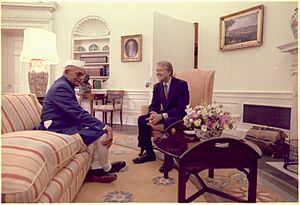
Leading the Nation
As Prime Minister, Desai worked to restore normal relations with China. This was the first time since the 1962 war between the two countries. He also built friendly relations with Pakistan's military leader, General Zia-ul-Haq.
India's Nuclear Program
Desai played an important role in India's nuclear program. After India conducted a nuclear test in 1974, other major nuclear powers were concerned. Desai stated that India's nuclear reactors would "never be used for atomic bombs." He promised that India would not make nuclear weapons or conduct more nuclear explosions.
Government Challenges
Desai's government changed some laws that were made during the Emergency. This made it harder for any future government to declare a national emergency. However, the Janata Party was made up of many different groups. There were often disagreements and conflicts within the party. This made it difficult for the government to achieve its goals.
In 1979, some members left the Janata Party. This forced Desai to resign from his position as Prime Minister. After this, he retired from politics.
Later Years and Legacy
Retirement and Passing
After retiring, Desai lived in Mumbai. He campaigned for the Janata Party in the 1980 elections but did not run himself. He was highly respected in his later years as a freedom fighter.
Morarji Desai passed away on April 10, 1995, at the age of 99. He was known for living a simple life and being a vegetarian.
Social Contributions
Desai was a follower of Mahatma Gandhi and a dedicated social worker. He helped build many institutions. He was the Chancellor of Gujarat Vidyapith, a university. Even as Prime Minister, he would visit and stay there. He was also involved in setting up the Amul Cooperative movement, which helped farmers.
Personal Life
Desai married Gujraben in 1911 when he was 15 years old. Gujraben lived to see her husband become Prime Minister. They had five children, but only three survived childhood: two daughters, Virumati and Indu, and a son, Kantilal.
Morarji Desai has two grandsons and one granddaughter through his son Kantilal. One of his great-grandsons, Madhukeshwar Desai, is currently a leader in the youth wing of the BJP political party.
Images for kids
See Also
 In Spanish: Morarji Desai para niños
In Spanish: Morarji Desai para niños


